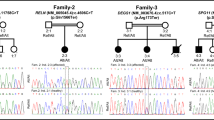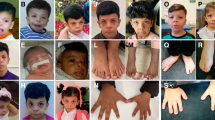Abstract
Cerebral cavernous malformations (CCMs) are congenital vascular anomalies of the central nervous system that can result in seizures, haemorrhage, recurrent headaches and focal neurologic deficit. CCMs can occur as an autosomal dominant trait with incomplete penetrance and a wide phenotypic variability. The genes responsible for this disease are KRIT1/CCM1 on chromosome 7q21.2, MGC4607/CCM2 on chromosome 7p15–p13 and PDCD10/CCM3 on chromosome 3q25.2–q27. Mutations in KRIT1/CCM1 account for more than 40% of CCMs. We previously reported a CCM family harbouring the KRIT1/CCM1 1204delAACAA mutation. In order to search for possible explanation of the clinical variability observed, we looked for genetic variation within exons and exon/intron regions in the three genes KRIT1, MGC4607 and PDCD10 associated to the disease within this large family, 23 subjects have been analysed. Identified genetic variations in the three genes are here presented. We believe that genetic variations could interfere with the proper CCM1/CCM2/CCM3 protein complex thus explaining the observed clinical variability.


Similar content being viewed by others
References
Battistini S, Rocchi R, Cerase A, Citterio A, Tassi L, Penco S (2007) Clinical, magnetic resonance imaging, and genetic study of 5 Italian families with cerebral cavernous malformation. Arch Neurol 64(6):843–848
Bergametti F, Denier C, Labauge P et al (2005) Mutations within the programmed cell death 10 gene cause cerebral cavernous malformations. Am J Hum Genet 76:42–51
Brunori P, Pelliccioli G, Campanella S et al (1997) Multiple cerebral cavernous malformations: study of a family. Riv Neurobiol 43:635–640
Cavè-Riant F, Denier C, Labauge P et al (2002) Spectrum and expression analysis of KRIT1 mutations in 121 consecutive and unrelated patients with cerebral cavernous malformations. Neurology 58:853–857
Chen L, Tanriover G, Yano H, Friedlander R, Louvi A, Gunel M (2009) Apoptotic functions of PDCD10/CCM3, the gene mutated in cerebral cavernous malformation 3. Stroke 40:474–1481
Craig HD, Guenel M, Cepeda O et al (1998) Multilocus linkage identifies two new loci for a Mendelian form of stroke, cerebral cavernous malformations at 7p15–13 and 3q25.2-27. Hum Mol Genet 7:1851–1858
Denier C, Goutagny P, Labauge P et al (2004) Mutations within the MGC4607 gene cause cerebral cavernous malformations. Am J Hum Genet 74:326–337
Dubovsky J, Zabramski JM, Kurth J et al (1995) A gene responsible for cavernous malformations of the brain maps to chromosome 7q. Hum Mol Genet 4:453–458
Gore AV, Lampugnani MG, Dye L, Dejana E, Weinstein BM (2008) Combinatorial interaction between CCM pathway genes precipitates hemorrhagic stroke. Dis Model Mech 1(4–5):275–281
Gunel M, Awad IA, Anson J, Lifton RP (1995) Mapping of a gene causing cerebral cavernous malformation to 7q11.2–q21. Proc Natl Acad Sci 92:6620–6624
Labauge P, Laberge S, Brunereau L, Levy C, Maciazek J, Tournier-Lasserve E (1998) Hereditary cerebral cavernous angiomas: clinical and genetic features in 57 French families. Lancet 352:1892–1897
Liquori LC, Berg MJ, Siegel AM, Marchuk DA (2003) Mutations in a gene encoding a novel protein containing a phosphotyrosine-binding domain cause type 2 cerebral cavernous malformations. Am J Hum Genet 73:1459–1464
Ma X, Zhao H, Shan J et al (2007) PDCD10 interacts with ste20-related kinase mst4 to promote cell growth and transformation via modulation of the ERK pathway. Mol Biol Cell 18:1965–1978
Pagenstecher A, Stahl S, Sure U, Felbor U (2009) A two-hit mechanism causes cerebral cavernous malformations: complete inactivation of CCM1, CCM2 or CCM3 in affected endothelial cells 1. Hum Mol Genet 18(5):911–918
Stahl S, Gaetzner S, Voss K et al (2008) Novel CCM1, CCM2, and CCM3 mutations in patients with cerebral cavernous malformations: in-frame deletion in CCM2 prevents formation of a CCM1/CCM2/CCM3 protein complex. Hum Mutat 29(5):709–717
Uhlik MT, Abell AN, Johnson NL et al (2003) Rac-MEKK3-MKK3 scaffolding for p38 MAPK activation during hyperosmotic shock. Nat Cell Biol 5:1104–1110
Voss K, Stahl S, Schleider E et al (2007) CCM3 interacts with CCM2 indicating common pathogenesis for cerebral cavernous malformations. Neurogenetics 8:249–256
Wang YGLH, Zhang YM, Ma DL (1999) cDNA cloning and expression of an apoptosis-related gene, human TFAR-15 gene. Science in China series C-life Sciences 42:323–329
Zabramski JM, Wascher TM, Spetzler RF et al (1994) The natural history of familial cavernous malformations: results of an ongoing study. J Neurosurg 80:422–432
Zawistowski JS, Serebriiskii IG, Lee MF, Golemis EA, Marchuk DA (2002) KRIT1 association with the integrin-binding protein ICAP-1: a new direction in the elucidation of cerebral cavernous malformations (CCM1) pathogenesis. Hum Mol Genet 11:389–396
Zawistowski JS, Stalheim L, Uhlik MT et al (2005) CCM1 and CCM2 protein interactions in cell signalling: implications for cerebral cavernous malformations pathogenesis. Hum Mol Genet 14(17):2521–2531
Zhang J, Clatterbuck RE, Rigamonti D, Chang DD, Dietz HC (2001) Interaction between KRIT1 and ICAP1α infers perturbation of integrin β1-mediated angiogenesis in the pathogenesis of cerebral cavernous malformation. Hum Mol Genet 10:2953–2960
Acknowledgments
The authors thank LICE (Lega Italiana Contro l'Epilessia) for the contribution to this study.
Author Contributions
Study concept and design: Silvana Penco
Acquisition of data: Silvana Pileggi and Serena Buscone
Analysis and interpretation of data: Silvana Penco, Silvana Pileggi, Alessandro Marocchi and Stefania Battistini
Drafting the manuscript: Silvana Penco and Silvana Pileggi
Administrative, technical and material support: Stefania Battistini, Claudia Ricci, Paola Brunori, Maria Cristina Patrosso and Silvana Penco
Author information
Authors and Affiliations
Corresponding author
Electronic Supplementary Material
Below is the link to the electronic supplementary material.
Supplemental Materials
DHPLC conditions for each amplicon of the three genes (DOC 87 kb)
Rights and permissions
About this article
Cite this article
Pileggi, S., Buscone, S., Ricci, C. et al. Genetic Variations Within KRIT1/CCM1, MGC4607/CCM2 and PDCD10/CCM3 in a Large Italian Family Harbouring a Krit1/CCM1 Mutation. J Mol Neurosci 42, 235–242 (2010). https://doi.org/10.1007/s12031-010-9360-y
Received:
Accepted:
Published:
Issue Date:
DOI: https://doi.org/10.1007/s12031-010-9360-y




